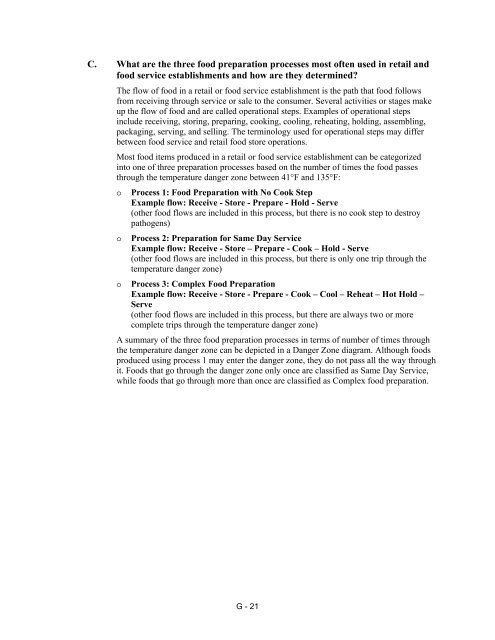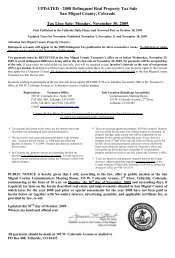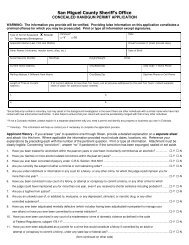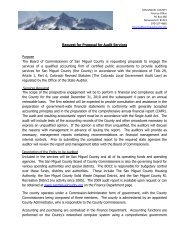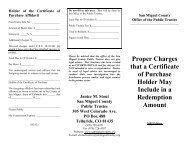colorado retail food establishment rules and ... - Boulder County
colorado retail food establishment rules and ... - Boulder County
colorado retail food establishment rules and ... - Boulder County
Create successful ePaper yourself
Turn your PDF publications into a flip-book with our unique Google optimized e-Paper software.
C. What are the three <strong>food</strong> preparation processes most often used in <strong>retail</strong> <strong>and</strong><br />
<strong>food</strong> service <strong>establishment</strong>s <strong>and</strong> how are they determined?<br />
The flow of <strong>food</strong> in a <strong>retail</strong> or <strong>food</strong> service <strong>establishment</strong> is the path that <strong>food</strong> follows<br />
from receiving through service or sale to the consumer. Several activities or stages make<br />
up the flow of <strong>food</strong> <strong>and</strong> are called operational steps. Examples of operational steps<br />
include receiving, storing, preparing, cooking, cooling, reheating, holding, assembling,<br />
packaging, serving, <strong>and</strong> selling. The terminology used for operational steps may differ<br />
between <strong>food</strong> service <strong>and</strong> <strong>retail</strong> <strong>food</strong> store operations.<br />
Most <strong>food</strong> items produced in a <strong>retail</strong> or <strong>food</strong> service <strong>establishment</strong> can be categorized<br />
into one of three preparation processes based on the number of times the <strong>food</strong> passes<br />
through the temperature danger zone between 41°F <strong>and</strong> 135°F:<br />
o<br />
o<br />
o<br />
Process 1: Food Preparation with No Cook Step<br />
Example flow: Receive - Store - Prepare - Hold - Serve<br />
(other <strong>food</strong> flows are included in this process, but there is no cook step to destroy<br />
pathogens)<br />
Process 2: Preparation for Same Day Service<br />
Example flow: Receive - Store – Prepare - Cook – Hold - Serve<br />
(other <strong>food</strong> flows are included in this process, but there is only one trip through the<br />
temperature danger zone)<br />
Process 3: Complex Food Preparation<br />
Example flow: Receive - Store - Prepare - Cook – Cool – Reheat – Hot Hold –<br />
Serve<br />
(other <strong>food</strong> flows are included in this process, but there are always two or more<br />
complete trips through the temperature danger zone)<br />
A summary of the three <strong>food</strong> preparation processes in terms of number of times through<br />
the temperature danger zone can be depicted in a Danger Zone diagram. Although <strong>food</strong>s<br />
produced using process 1 may enter the danger zone, they do not pass all the way through<br />
it. Foods that go through the danger zone only once are classified as Same Day Service,<br />
while <strong>food</strong>s that go through more than once are classified as Complex <strong>food</strong> preparation.<br />
G - 21


